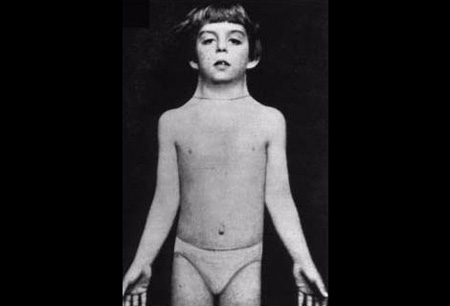History and exam
Key diagnostic factors
common
poor growth
A girl with Turner syndrome is relatively small from infancy and usually falls below the 5th percentile for height on age- and sex-specific growth charts by 10 years of age.
short stature
Short stature is often the primary symptom. A girl with Turner syndrome is relatively small from infancy but proportionate. The mid-parental height prediction helps identify a child who is short for her parents and not following her genetic track.
delayed/absent pubertal development
Sexual hair is typically sparse and pubertal development minimal. The largest proportion of detection is at 10 to 16 years of age, owing to a combination of marked short stature and delayed puberty.
primary amenorrhea
The ovaries form normally in 45,X female fetuses, although most demonstrate accelerated oocyte death and ovarian degeneration into fibrous streaks.[19] Patients present with delayed puberty and primary amenorrhea.
congenital heart defects
Aortic coarctation and bicuspid aortic valves are the most common abnormalities. Other cardiac abnormalities include partial anomalous pulmonary veins, left heart hypoplasia, and a dilated aorta. Prevalence of cardiovascular defects is much higher in those with clear evidence of fetal lymphedema, such as neck webbing. Two genes,TIMP1 and TIMP3, which are both located on the short arm of the X chromosome when hemizygous increase the risk of aortopathy with an odds ratio of 12.86.[17]
skeletal abnormalities
Wide carrying angle (>30 degrees) owing to in-turned elbows (cubitus valgus), short fourth metacarpals or metatarsals, and, rarely, a Madelung deformity (prominent distal ulna), as well as scoliosis. [Figure caption and citation for the preceding image starts]: Classic stigmata of Turner syndromeFrom Ullrich O. Eur J Pediatr. 1930;49:271-276; used with permission [Citation ends].
uncommon
webbed neck
Skin folds extending from mastoid to acromion. It is a common manifestation of fetal lymphedema (swelling of the fetal tissues, especially of the head and neck, due to impaired lymphatic development).
Prevalence of congenital heart disease is much higher in those with neck webbing.
peripheral lymphedema
Presents as puffy dorsum of the hands or feet. May be present in the neonatal period, leading to a suspicion of the diagnosis.
Other diagnostic factors
common
dysmorphic features
Low-set or malrotated ears, down-sloping eyes, ptosis or hooded eyes, and low posterior hairline are pathognomonic. A high-arched palate, although common, is not specific for Turner syndrome. [Figure caption and citation for the preceding image starts]: Classic stigmata of Turner syndromeFrom Ullrich O. Eur J Pediatr. 1930;49:271-276; used with permission [Citation ends].
Low-set ears and a low posterior hairline are common sequelae of fetal lymphedema (swelling of the fetal tissues, especially of the head and neck, due to impaired lymphatic development).
secondary amenorrhea
Approximately 15% of girls continue to have functional ovarian tissue with spontaneous puberty and may menstruate for a number of years before experiencing premature ovarian failure.[5] Some girls will begin development and then arrest.
multiple melanocytic nevi
Commonly seen in Turner syndrome.
recurrent/severe otitis media
Unusually severe or frequent bouts of otitis are common in childhood.
systolic ejection murmur and/or click
Suggestive of bicuspid aortic valve, occurring in approximately 30% of patients.
poor social skills
Observed frequently in Turner syndrome.
eye abnormalities
Strabismus, amblyopia, hyperopia and myopia, ptosis and color blindness have all been reported. Girls with Turner Syndrome have an epicanthal fold (upper eyelid fold that covers inner corner of eye) and hypertelorism (increased distance between eyes).
uncommon
upper extremity hypertension
Hypertension in one or both upper extremities suggests aortic coarctation.
dystrophic and/or hyperconvex nails
Present in girls with Turner syndrome.
Risk factors
strong
there are no known risk factors
Use of this content is subject to our disclaimer